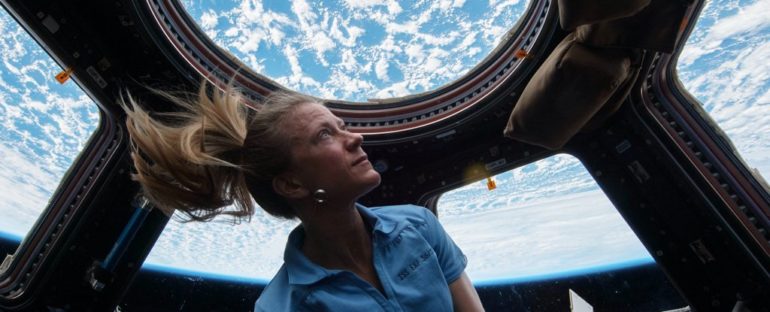Space is a hostile place. We may have developed the technology to launch astronauts into orbit and get them home safely, but scientists are still figuring out how space travel affects human health, especially over the long haul.
That’s essential before any planned missions to Mars go ahead, to assure the health and safety of the astronauts aboard those momentous flights.
We already know from astronaut studies – perhaps most famously, NASA’s Twins Study co-starring identical twins Scott and Mark Kelly – that extended space time affects blood flow to the brain, alters the gut microbiome, increases inflammation and causes blurred vision, brittle bones, and muscle wasting.
Mouse studies simulating spaceflight have also suggested that heading into space ages the immune system and damages the brain.
Now, in a huge collective effort, scientists have published a giant trove of almost 30 papers investigating the health risks associated with space travel.
The collection amounts to the largest set of space biology data ever produced, and features some hefty analyses of observations from space-going flies, worms, mice, and of course, astronauts.
Some of the results reaffirm what we knew about space-related health problems, while other studies provide new insights, clarify previous results, or have found ways to improve future experiments.
“Although significant advances have been made in the past decade to understand [the] health risks [of space travel], additional research is required to enable safer human space exploration beyond [low Earth orbit], including lunar, Mars, and deep-space missions,” the researchers write in an over-arching review paper that fronts the collection.
The health perils of space travel start with the G forces felt by astronauts on lift-off, and continue with the exposure to hazardous space radiation and microgravity while in space.
On the treacherous journey to Mars, for example, astronauts will go far beyond Earth’s protective magnetosphere and be exposed to cosmic radiation during the significant stretch of time it will take for them to venture out to our nearest planetary neighbour and return.
For astronauts hovering in low gravity aboard the International Space Station (ISS), the longest stay of any astronaut is currently sitting at 437 days. Clearly, we still have a long way to go to truly appreciate what the health risks of long-distance space flights might be, and scientists just have to work with the data we’ve got.
Many of the studies published in this collection have pooled or re-analysed data from previous experiments made available to researchers through open-access data portals such NASA’s GeneLab platform.
Combining data like this is a way to strengthen the resulting analyses (often researchers look to see if what was found in one dataset holds true in another), and maximise the data collected from costly spaceflights.
“A collective analysis across multiple models and human studies can lead to a more comprehensive understanding of physiological and human health-related impacts of the space environment,” the researchers write, explaining their approach.
One study, for example, analysed data from close to 60 astronauts and hundreds of GeneLab samples to look for a universal mechanism linking the widespread health changes that have been observed in different genes, cells, tissues, body systems, organs, and muscles.
Across the board, the study showed “systemic shifts” in the function of mitochondria – which are the power packs inside our cells, converting oxygen and nutrients into energy.
“What we found over and over was that something is happening with the mitochondria regulation that throws everything out of whack,” said Afshin Beheshti, a bioinformatician at NASA’s Ames Research Center.
This might explain the disruptions observed in astronauts’ immune systems and circadian rhythms, the authors write.
Another study compared data from the Kelly twins with 11 unrelated astronauts who spent around six months on the ISS, looking specifically at their telomeres. These are the protective caps on the ends of our chromosomes, which typically erode with age.
Unexpectedly, the researchers found that some of the astronauts’ telomeres got longer during their spaceflight, but the group generally had shorter telomeres after returning than they did before they took flight.
“Going forward, our goal is to get a better idea of underlying mechanisms, of what’s going on during long-duration space flight in the human body, and how it varies between people,” said Susan Bailey, an expert in telomere biology at Colorado State University. “Not everybody responds the same way.”
There were also some interesting findings from a study that re-analysed data from NASA’s Twins Study. It suggested that the spike in inflammatory molecules observed in Scott Kelly’s blood when he returned to Earth (after 340 days on the ISS) could be a marker of muscle regeneration rather than an immune response.
These studies are obviously limited by the very small number of astronauts and animals we can send into space – which is where the worms and flies come in. Using these creatures is an easy way to scale-up spaceflight experiments, so they feature in the papers, too.
A study of roundworms on the ISS found subtle changes in roughly 1,000 genes, particularly those relating to nerve cell function, while another study, this time with flies, suggested that a lengthy stay in microgravity reduces the strength of their beating heart.
All in all, this collection of papers – the work of some 200 researchers from NASA and other government agencies, universities, and aerospace industry groups – represents a solid contribution to our understanding of the health risks of hanging out in space.
The full list of published papers has been collated in the journal Cell.



